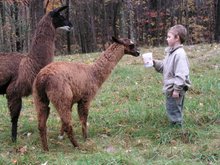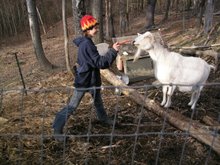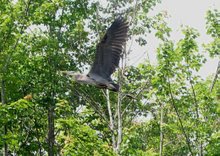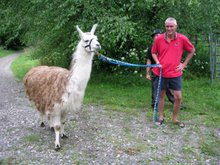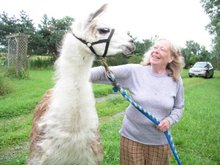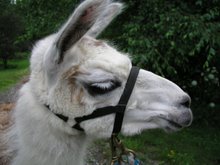
2008....Did you know that the average person writes 2007 over 100 times before they get 2008? I hope I remembered that on all of the checks I wrote today for bills. It is nice to be settled in to the school routine again, I really like going to work every day and I like the routine. I am really glad that vacation/holidays are over.
Not much is new from the last time I blogged. I have gotten a new llama in. An intact male, I have to get him gelded by my vet. He is halter broke and should be very adoptable once he is gelded. He came with lots of support but no money to pay the vet bills..I hope that this one will eventually come back to reward my efforts..
The potbelly pig sow that had piglets (as a baby herself) didnt end in a perfect situation. She was a trooper and tried. Ive gotten so many emails in the last week that it is almost a fulltime job. Ive started getting a lot of emails for advice....I love the educational aspect of what I do...I love telling someone how to catch a llama on the loose. But it still is depressing to know that people are still selling animals that are "wild" and offer no support when a scared animal gets loose. Few "reputable" breeders do what is right and that makes the job of all of us rescue folks that much more difficult.
My day today is going better than yesterday. Yesterday morning, at about 430 am, I woke up feeling kinda cold. When I am teaching, I always wake up an hour before my alarm clock, but this was different....I was cold. I noticed that the Great Dane and my wife were hogging more blankets than normal. I also noticed that my 5 yr. old (Emma) had crawled into bed with us at some point. I looked at my thermometer by my bed and it said that it was negative 6 outside but it felt like it in the house. I got up and made coffee in the 50 degree cold (no one likes a wife without coffee). I went downstairs into the dungeon, a really grim place. Our house is built on a stone foundation, the basement is really someplace not worth visiting. I tried to bleed the lines to the furnace....when nothing came out...I knew I was in trouble. It was so darn cold that the fuel line from the furnace to the outside oil tank had froze. It just is another reason to hate winter...Im not even talking about frozen hoses, water tubs, and life in general.
The highlight of my day today. Gayle (our webmaster) and Cherryl (picking up my son for a sleepover) stopped by. Colin (farm manager) came by on a snowmobile and we had an informal BOD meeting. I really think that 2008 will be the year that people realize what we are doing. I look forward to my program at St. Andrews in Albany next week.
As we start 2008, I try to think about 2007....What we do is a tough thing here but I am really confident that with this group of people ,and with your, help we can continue to help both the domestic livestock that we pick up and the onslaught of wildlife this spring. Wes
 pretty exciting. See the Wildlife Blog for the story on New York Wildlife Rescue Center Blog. Ive lost my voice (my students probably love that). We have gotten a lot done around the farm over the weekend. Colin has been a great help along with my barn kids. We set up a new Bunny area, A new huge quarantine pen and set up a proper place for hay storage. I want to design a raptor/hawk pen next for rescues that come in as I do my apprenticeship.
pretty exciting. See the Wildlife Blog for the story on New York Wildlife Rescue Center Blog. Ive lost my voice (my students probably love that). We have gotten a lot done around the farm over the weekend. Colin has been a great help along with my barn kids. We set up a new Bunny area, A new huge quarantine pen and set up a proper place for hay storage. I want to design a raptor/hawk pen next for rescues that come in as I do my apprenticeship.











